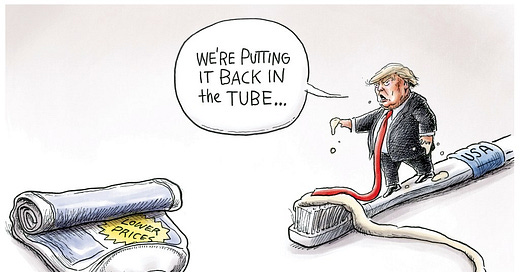Bonds Speak Louder: Why Tariffs Took a Step Back Last Week
What the Bond Market Just Told Us (And Why Even Trump Had to Listen)
Let me tell you a simple story about something that sounds complicated—but is actually one of the most important forces in the financial world: the bond market.
📜 What’s a Bond, Anyway?
Imagine this: the U.S. government needs money. Instead of going to a bank, it sells a promise (“IOU”)—called a bond. You give the government $100, and they promise to pay it back later with some extra—that extra is called interest, or a yield.
These bonds are considered super safe, which is why people all over the world buy them—from everyday investors to massive foreign governments like China and Japan.
🌍 The Marketplace for Bonds
Think of the bond market like a big farmer's market. Sellers (the U.S. government) offer bonds, and buyers (like you, me, and foreign countries) come looking for a deal. If a lot of people want bonds, prices stay high and yields stay low. But if people stop buying, prices fall and yields rise. Bonds, like any other asset in the economic world, follow the basic principles of supply and demand.
Why? Because the government still has to make the bond attractive, so they raise the yield to lure in new buyers. Higher yield = higher cost for the government to borrow.
💥 Then Came the Tariffs...
Last week, former President Trump proposed a 100%+ tariff on Chinese goods. That’s a massive tax on imported products like electronics, clothes, and furniture.
Here’s where it gets interesting.
Countries like China hold trillions of dollars in U.S. Treasury bonds. But if they feel like America is taking aggressive actions, like massive tariffs, they might stop buying U.S. bonds and Worst they can sell the bonds they are currenly holding.
And that’s exactly what started to happen.
📉 The Bond Sell-Off & Yield Spike
Foreign investors, worried about trade wars and inflation, started selling their U.S. bonds. Too many sellers, not enough buyers = bond prices dropped.
And remember: when bond prices drop, yields go up.
One of the most watched metrics, the 10-year Treasury yield jumped from 3.99% to 4.51% in just a few days. That’s a huge move in bond world terms.
💸 Why Rising Yields Matter
Here’s the real kicker: the U.S. government is $36 trillion in debt. Higher yields mean higher interest payments, costing taxpayers hundreds of billions more each year.
Think of it like this: the government's credit card interest just went way up, and that squeezes spending for everything else schools, defense, infrastructure, healthcare, etc. This also increases interest rates for businesses to borrow.
Markets don’t like uncertainty. The S&P 500 dropped 12% in four days, as investors feared tariffs would raise prices, slow the economy, and make everything more expensive from groceries to mortgages.
🧯 Then Trump Backpedaled
On April 9, Trump announced a 90-day pause on the tariffs (though notably, not for China). It was seen as an attempt to calm the markets.
And it worked a little. Bond yields stopped rising so quickly, and the panic started to cool off.
📖 So, What Did We Learn?
The bond market is the quiet voice that often speaks loudest.
When investors lose confidence, or foreign buyers pull back, the bond market reacts and that reaction affects everything: interest rates, government borrowing, and even political decisions.
Even someone as loud as Trump had to listen when the bond market started screaming.
✅ Conclusion
If you want to understand where the economy might be headed, keep an eye on the bond market. It’s often smarter, calmer, and more honest than all the headlines combined.
That’s it for Today!
Final Thoughts
A bond is a “IOU” issued by the government to borrow money
Bond yields and prices move in opposite directions.
Rising yields ripple through the economy, as borrowing becomes expensive
As an investor, it is good to be familia with the bond market as it can provide some good information on the Market.
As always, no one can predict the future or how an economy unfolds but this will help us to better understand how the companies in our portfolio can be impacted.
About Me
I am a self-taught investor who has read hundreds of books on investing and spends 40+ hours a week researching and analyzing stocks. Steady Investing has a true passion for investing and helping other investors.
I did not come from a finance background, and it took me nearly 10 years from first learning about the stock market to finally making my first investment. Since 2022, when I started tracking my performance, I have beaten the S&P 500 Index every year on average by 20 %+ and have achieved a 40% compound annual growth rate (CAGR).
I created this platform to share my investing journey and help others navigate the stock market with confidence.
Let’s grow together. 🚀
Visit my page to access previous posts.
Disclaimer: This post is for educational purposes only and should not be considered financial advice. Always do your research before making investment decisions.






What a great explanation of everything in plain English!
Great summary of what bonds are and why they are so important to the functioning of our modern financial system!